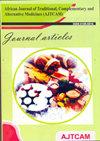水甲醇提取物的抗氧化、抗炎和抗伤害性研究CUFOD叶
African Journal of Traditional, Complementary and Alternative Medicines
Pub Date : 2017-11-15
DOI:10.21010/AJTCAM.V14I6.6
引用次数: 4
摘要
背景:Eremomastax speciosa (Hochst.)Cufod是一种多年生草本植物,生长在非洲的热带雨林地带,以杂草的形式出现。由于其药用价值,它在喀麦隆和尼日利亚的阿夸-伊博姆种植。本实验研究了白藜芦醇提取物的抗氧化、抗炎和抗伤性。大鼠模型中的牛蒡叶。材料与方法:采用80%氢甲醇冷浸法提取植物材料。急性口服毒性试验采用上下法,限定剂量为2000 mg/kg。采用2,2-二苯基-1-苦味酰肼和铁还原抗氧化能力光度法评价其体外抗氧化性能。在鸡蛋白蛋白和卡拉胶诱导的足跖水肿模型中研究其抗炎作用,在50、100和200 mg/kg剂量下通过乙酸诱导扭体反射和尾浸试验测定其抗炎活性。阴性对照组(A组)给予5 ml/kg蒸馏水(载药),乙酰水杨酸(200 mg/kg)作为抗炎模型和醋酸扭体反射模型的对照药,戊唑嗪(5 mg/kg)作为浸尾试验的对照药。结果:该提取物的LD50大于2000 mg/kg。该提取物(25 ~ 400 μg/ml)在2,2-二苯基-1-苦味酰肼和铁还原抗氧化能力试验中均表现出较强的抗氧化活性。与蒸馏水组相比,黄芪提取物组大鼠抗炎、抗伤活性显著(P < 0.05)。提取液在100 mg/kg时活性最佳。结论:本研究支持了传统医学中利用金针叶治疗疼痛和炎症的观点。本文章由计算机程序翻译,如有差异,请以英文原文为准。
ANTIOXIDANT, ANTI-INFLAMMATORY AND ANTI-NOCICEPTIVE PROPERTIES OF HYDRO-METHANOL EXTRACT OF EREMOMASTAX SPECIOSA (HOCHST.) CUFOD LEAF
Background: Eremomastax speciosa (Hochst.) Cufod is a perennial herb found in Africa along the rainforest zone and occurs as weed. It is cultivated in Cameroon and Akwa-Ibom in Nigeria due to its medicinal values. This study investigated the antioxidant, anti-inflammatory and antinociceptive properties of hydromethanol extract of Eremomastax speciosa (Hochst.) Cufod leaf in rat model.
Materials and Methods: The plant material was extracted using cold maceration method in 80% hydromethanol. The acute oral toxicity test was performed using Up and Down method with limit dose of 2000 mg/kg. The in vitro antioxidant property was evaluated with 2,2-diphenyl-1-picrylhydrazyl and ferric reducing antioxidant power photometric assays. The anti-inflammatory potential was investigated in egg-albumin and carrageenan induced paw edema models while the antinociceptive activity was determined using acetic acid induced writhing reflex and tail immersion tests at the doses of 50, 100 and 200 mg/kg. The negative control group (group A) received distilled water (vehicle) at 5 ml/kg while acetyl salicylic acid (200 mg/kg) was used as the reference drug for the anti-inflammatory models and acetic acid induced writhing reflex model while pentazocine (5 mg/kg) was used as the reference drug for tail immersion test.
Results: The LD50 of the extract was greater than 2000 mg/kg. The extract (25 to 400 μg/ml) demonstrated potent antioxidant activities in both the 2,2-diphenyl-1-picrylhydrazyl and ferric reducing antioxidant power assays. The E. speciosa extract caused significant (P < 0.05) anti-inflammatory and antinociceptive activities in the extract treated groups when compared to rats that received distilled water. The optimal activities of the extract were produced at the dose of 100 mg/kg.
Conclusion: The study supports the folkloric use of Eremomastax speciosa leaf in the management of pain and inflammatory conditions in traditional medicine.
求助全文
通过发布文献求助,成功后即可免费获取论文全文。
去求助
来源期刊
自引率
0.00%
发文量
0
审稿时长
6-12 weeks
期刊介绍:
The “African Journal of Traditional, Complementary and Alternative Medicines (AJTCAM)” is a peer-reviewed, multidisciplinary, international, scientific Open Access Journal that provides publication of articles on phytomedicines, ethnomedicines and veterinary ethnomedicines. The journal is published by a Non-Governmental Organization (NGO) known as “African Traditional Herbal Medicine Supporters Initiative (ATHMSI)”. The Journal welcomes submission of manuscripts that meet the general criteria of significance and scientific excellence. Papers will be published approximately two-to-three months after acceptance

 求助内容:
求助内容: 应助结果提醒方式:
应助结果提醒方式:


